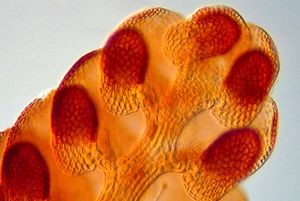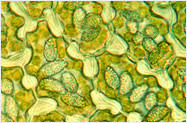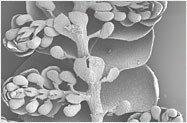Biodiversity
 Stem habit of the naturally uncommon Frullania knightbridgei. Photo: Matt von KonratLiverworts, together with mosses and hornworts are commonly referred to as bryophytes, which constitute the second largest group of land plants after flowering plants. The estimated number of liverwort species range from 6000 to 8000 and are remarkably diverse considering their relatively small size. Traditionally, liverworts have been subdivided into two major groups or classes based, partially, on growth form.The class Marchantiopsida, includes the well-known genera Marchantia, Monoclea, Lunularia and Riccia, and has a complex thalloid organisation.
Stem habit of the naturally uncommon Frullania knightbridgei. Photo: Matt von KonratLiverworts, together with mosses and hornworts are commonly referred to as bryophytes, which constitute the second largest group of land plants after flowering plants. The estimated number of liverwort species range from 6000 to 8000 and are remarkably diverse considering their relatively small size. Traditionally, liverworts have been subdivided into two major groups or classes based, partially, on growth form.The class Marchantiopsida, includes the well-known genera Marchantia, Monoclea, Lunularia and Riccia, and has a complex thalloid organisation.
The class Jungermanniopsida represents an estimated 85% of liverwort species and shows an enormous amount of morphological, anatomical and ecological diversity; plants with leafy shoot systems are the most common growth form in this class, e.g., Frullania, Jubulopsis, Cololejeunea, and Radula. Of worldwide significance is the fact that New Zealand is home to an estimated 5-10% of the world’s liverwort species and with over 200 of the species endemic. Moreover, over 50% of the liverwort families (48 of 74) and a high proportion of genera are also represented in the New Zealand botanical region.
Ecological & biological significance
 Frullania squarrosula, oilbodies which are unique to liverworts and not found in any other group of plant. Photographer: Matt von Konrat.Liverworts, along with mosses have a significant role in contributing to nutrient cycles, providing seed-beds for the larger plants of the community, and form microhabitats for insects and an entire array of microorganisms. Liverworts and mosses are also very effective rainfall interceptors, and the overwhelming abundance of epiphytic bryophytes in temperate rainforests is considered an important factor in eliminating the deteriorating effect of heavy rains, including adding to hill stability and helping to prevent soil erosion. The chemical compounds of some liverworts are also particularly interesting because they have important biological activities, for example, activity against certain cancer cell lines, anti-bacterial properties, anti-microbial, anti-fungal, and muscle relaxing activity. These chemical compounds are found in the oilbodies, which are a specialised cellular organelle unique to liverworts.
Frullania squarrosula, oilbodies which are unique to liverworts and not found in any other group of plant. Photographer: Matt von Konrat.Liverworts, along with mosses have a significant role in contributing to nutrient cycles, providing seed-beds for the larger plants of the community, and form microhabitats for insects and an entire array of microorganisms. Liverworts and mosses are also very effective rainfall interceptors, and the overwhelming abundance of epiphytic bryophytes in temperate rainforests is considered an important factor in eliminating the deteriorating effect of heavy rains, including adding to hill stability and helping to prevent soil erosion. The chemical compounds of some liverworts are also particularly interesting because they have important biological activities, for example, activity against certain cancer cell lines, anti-bacterial properties, anti-microbial, anti-fungal, and muscle relaxing activity. These chemical compounds are found in the oilbodies, which are a specialised cellular organelle unique to liverworts.
Difference between liverworts from other bryophytes
 Scanning electron micrograph of the plant habit of Frullania ptychantha. Photographer: Mat von Konrat.The following outlines certain straightforward differences between mosses and liverworts:
Scanning electron micrograph of the plant habit of Frullania ptychantha. Photographer: Mat von Konrat.The following outlines certain straightforward differences between mosses and liverworts:
- Capsule opening mechanisms (spore producing sac): In most liverworts, when a spore capsule is ripe, it typically opens along four longitudinal axes; moss capsules nearly always have rather more complex opening mechanisms, but typically open at the end to let the spores out.
- Structure of rhizoids (root-like structures): In liverworts, the rhizoids are nearly always composed of a single, elongated cell; in mosses the rhizoids are multicellular.
- Early development of the gametophyte (dominant phase of the life-cycle): In mosses, following spore germination, a juvenile stage known as a protonema forms, which is followed by the development of the mature gametophyte plant; this is absent or much reduced in liverworts.
 Frullania rostrata, growing as a festoon from a branch. Photographer: John BragginsOther differences that are useful in differentiating between mosses and liverworts include the following:
Frullania rostrata, growing as a festoon from a branch. Photographer: John BragginsOther differences that are useful in differentiating between mosses and liverworts include the following:
- The leaves of many liverworts are deeply lobed or divided; few mosses have leaves like this.
- All liverworts with a leafy structure have their leaves arranged in a two- or three-rowed pattern; very few mosses have this sort of arrangement of leaves.
- Many mosses have leaves with a distinctive, thickened nerve; in comparison, only a few liverworts have leaves with such nerves e.g., the Pallaviciniaceae family.
- In liverworts, the seta (or stalk) of the sporophyte are thin, white or translucent, and quite weak and fragile; in mosses the seta is green or brown, and strong and sturdy.
 Frullania rostrata (left), ventral view, under the light microscope. Photo: Matt von Konrat.For more information go to*:
Frullania rostrata (left), ventral view, under the light microscope. Photo: Matt von Konrat.For more information go to*:
- A Flora of the Liverworts and Hornworts of New Zealand, Volume 1, by John J. Engel and David Glenny published by Missouri Botanical Gardens Press
*The Network is not responsible for the content of external internet sites
